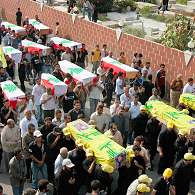2006年VOA标准英语-Lebanese Bury Victims of Qana Airstrike(在线收听)
By Challiss McDonough
Qana, Lebanon
19 August 2006
 Funeral procession in Qana |
||
----
The victims of Qana were laid to rest amid a mix of grief and anger. There were 29 graves, dug in neat rows just 100 meters from the crumpled house where the bodies were dug from the rubble 18 days earlier.
Clutching a photo of her dead sister Khadija, Fayrouz Younes could barely speak through her tears. She choked back sobs as she recalled how she learned of the death of her sister, and Khadija's five children.
She says she saw the catastrophe on television, but nobody told her that her sister had been killed. She only found out hours later, when someone offered her condolences, not realizing that she did not know of Khadija's death.
Her tears dripped onto the photo of her sister, and then she recited the names of Khadija's dead children: Hura, Yehia, Ali, Zahra and Qassim Chalhoub.
Everyone killed in the Qana airstrike came from one of two families, the Chalhoubs and the Hashems. Roughly half of the dead were children.
The funeral in Qana was one of many on Friday. There were more than 200 funerals in other villages throughout south Lebanon. In Tyre, workers exhumed bodies that had been buried in temporary mass graves during the war.
Ambulances carrying the coffins were followed by long lines of cars full of relatives, heading back to their villages to bury the dead, five days after the conflict ended.
Here in Qana, mourners carried the coffins through the streets of town to the burial place.
Pounding on their chests, they pledged their loyalty to Hezbollah, and denounced America and Israel.
Twenty-six of the coffins were covered with Lebanese flags and three of them with yellow Hezbollah flags. Those were the coffins of Hezbollah fighters from Qana, but the militia said they had been killed elsewhere -- in Bint Jbail and Ait Esh Shaab.
The Shi'ite cleric leading the prayers said the United States and Israel were "partners" in the killing of Lebanese people.
A mourner who gave her name only as Kamla reminded visitors that the United States speeded up a delivery of bombs to Israel during the conflict.
"Tell Bush that those 'smart bombs' are not smart .... They killed not one resistance fighter here, only women and children," she said.
Israel has apologized for the Qana airstrike, calling it "a mistake." But for residents of the town, it is hard to believe that the powerful and technologically advanced Israeli military could make such a grave error truly by accident.
All day, unmanned Israeli reconnaissance planes circled overhead, a constant reminder that the Israeli military is still monitoring activity in southern Lebanon even after the ceasefire. Mohamed Chalhoub lost his daughter, sister and brother in the airstrike and was wounded himself.
He gestured at the sky and said, "Those planes were up there 24 hours a day before the attack. I am sure they saw everything." He said they must have seen women and children coming in and out of the building.
At the end of the day, the television cameras were gone, and relatives of the victims stood silently, some of them quietly weeping as they watched men shovel earth over the 29 graves.